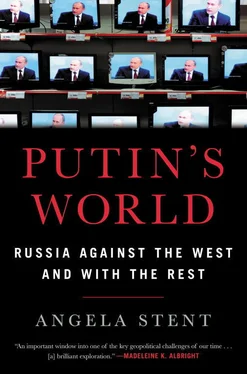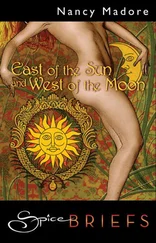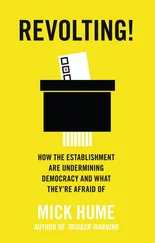Let me note too that we have already heard declarations from Kiev about Ukraine soon joining NATO. What would this have meant for Crimea and Sevastopol in the future? It would have meant that NATO’s navy would be right there in this city of Russia’s military glory, and this would create not an illusory but a perfectly real threat to the whole of southern Russia. These are things that could have become reality were it not for the choice the Crimean people made, and I want to say thank you to them for this. 50
Russian actions since the annexation of Crimea have produced a counterreaction by NATO that has significantly escalated tensions between the two players. NATO initially responded cautiously to the seizure of Crimea and to the outbreak of war in the Donbas region. NATO had been working with the Ukrainian military, under the terms of Ukraine’s own partnership agreement, to strengthen the Ukrainian armed forces, but it was not obligated to come to Ukraine’s defense.
The Kremlin has consistently asserted that it has no regular troops supporting the separatists in the Donbas region—a claim that has been refuted by reliable photographic evidence. The Russian military contracting firm Wagner has sent mercenaries to fight in Ukraine. 51Putin has admitted only that there were Russian military intelligence officers in the Donbas. 52The Kremlin says that if Russian soldiers are there, they are fighting on their “vacation” time. Moreover, the Russian NGO Committee of Soldiers’ Mothers has described the body bags with hundreds of dead soldiers that have returned to Russia from Ukraine. 53But Kremlin spokesman Dmitry Peskov has adamantly denied these claims: “We have stated many times that there are no Russian troops on the territory of Ukraine. It is simply an obsession to ascribe Russia a destructive role in the development of the Ukrainian crisis with which we categorically disagree.” 54
NATO’s RESPONSE TO RUSSIA’S WARS WITH GEORGIA AND UKRAINE
This Kremlin’s insistence on “alternative facts” has increased NATO’s suspicions about Russian motivations and future plans, and rendered discussions in the NATO-Russia Council very challenging. NATO’s response has been to reverse twenty-five years of drawing down its presence near Russia’s borders and recommit to its original goal: defending its members from outside aggression, including from Russia. In 1997, there were 100,000 NATO troops in Europe. In 2014, there were only 25,000. In July 2014, at its summit in Wales, NATO focused on Russia’s invasion of Ukraine:
We condemn in the strongest terms Russia’s escalating and illegal military intervention in Ukraine and demand that Russia stop and withdraw its forces from inside Ukraine and along the Ukrainian border. This violation of Ukraine’s sovereignty and territorial integrity is a serious breach of international law and a major challenge to Euro-Atlantic security. We do not and will not recognize Russia’s illegal and illegitimate “annexation” of Crimea. 55
NATO subsequently agreed to establish a Very High Readiness Joint Task Force (VJTF), a new allied force that would be able to deploy within a few days to respond to challenges that arise, particularly at the periphery of NATO’s territory. It also exhorted its members to meet their commitment to spend at least 2 percent of their GDP on defense, something on which President Trump has insisted to every European leader he has met.
At its Warsaw summit in 2016, the alliance explicitly moved from “reassurance” to “deterrence,” a major shift since the more optimistic years after the end of the Cold War. It was clear whom the alliance believed it needed to deter. The symbolism of holding a NATO summit in Warsaw, where the Soviet-era Warsaw Pact was founded, was lost on neither the Poles nor the Russians. One Russian newspaper dubbed it “the first in many years to have such an openly anti-Russian agenda.” There was no hint in the official Russian media that NATO was reacting to Russia’s ongoing conflict with Ukraine and its military buildup in the Baltic Sea, just as Russian attacks on EU sanctions neglected to explain why the sanctions had been imposed in the first place. This has been a Russian pattern at least since Stalin, who failed to acknowledge that NATO was founded in response to the Soviet takeover of Eastern Europe. Russian leaders are acting as if they had no agency in any of these developments.
NATO agreed to deploy military forces and forward-positioning equipment to the Baltic states and eastern Poland in January 2017 to deter Russia, in response to Moscow’s moves in Crimea and the Donbas. The four battalions, totaling between three and four thousand troops, are led by the UK in Estonia, the US in Poland, Canada in Latvia, and Germany in Lithuania. Furthermore, NATO took command of a US-built missile shield in Europe to defend against ballistic missiles from Iran. It also agreed to welcome Montenegro as its newest member. NATO secretary-general Jens Stoltenberg warned about growing Russian activity in the Balkans, discussed earlier. The Balkans has become the latest battleground where the Kremlin seeks to counter southeast Europe’s move westward.
The European Deterrence Initiative of the US Department of Defense has enhanced these NATO efforts. 56To Russian complaints about this new military buildup, Stoltenberg replied: “But this is not an egg and chicken situation because there’s no doubt that it was Russia’s aggression against Ukraine, annexing Crimea and continuing to destabilize Eastern Ukraine, that triggered the NATO response. Before Russia started its aggressive actions against Ukraine, no one was seriously talking about any enhanced NATO presence in the eastern part of the alliance.” 57
In January 2017, these new NATO deployments took place. The deployment in Poland was the largest infusion of US troops in Europe since 1991. For Germany, sending troops to Lithuania remained a sensitive issue in both Germany and Lithuania, given the legacy of World War Two; but these ghosts of the past were dwarfed by concerns about Russian aggression.
As the new NATO deployments began, Russia threatened retaliation. According to Kremlin spokesman Dmitry Peskov, “We perceive it as a threat. These actions threaten our interests, our security. Especially as it concerns a third party building up its military presence near our borders.” 58
The spiral of reaction and counterreaction in NATO-Russia relations shows no signs of abating. Russia claims that it moved into Crimea because it feared that its security would be threatened if Ukraine joined NATO and the alliance moved up to its borders. NATO in return has beefed up its forces near Russia’s borders because the Baltic states and Poland felt threatened. Whereupon Russia announced that it would retaliate militarily to these new deployments. Is it possible to break out of this cycle?
Would Russia’s relations with the West have been that different had NATO not enlarged? If NATO had disbanded itself in the early 1990s, what security arrangement might have replaced it? Even in 1992, a weakened Russia reeling from the Soviet collapse still regarded the former republics of the Soviet Union as its “near abroad,” not independent countries with sovereign rights. It was more willing to accept that Central Europe had become independent but still was hardly in a position to begin a serious consideration of what it believed a Euro-Atlantic security system should be. And the OSCE—the one existing multilateral security organization that included North America, Europe, Russia, and the post-Soviet states—was not a substitute for a successful military alliance that had kept the peace for nearly five decades. In the 1990s, the United States drastically reduced its military presence in Europe, and NATO explicitly shifted its mission from deterring the Soviet Union to working cooperatively with the former communist countries to create a Europe “whole and free.” In the uncertain years after the end of the Cold War, the dissolution of NATO would have led to a dangerous security vacuum in Europe. And Russia was not in a position to suggest or provide alternative arrangements.
Читать дальше












